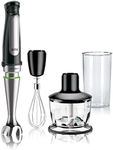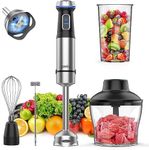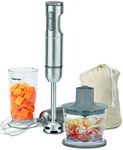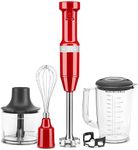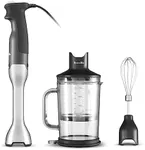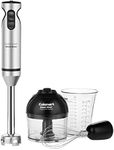Buying Guide for the Best Immersion Blenders
Choosing the right immersion blender can make your kitchen tasks much easier, whether you're blending soups, making smoothies, or whipping up sauces. The key is to think about what you'll use it for most often and match the features to your needs. Immersion blenders are handy because they're compact, easy to clean, and can blend directly in your pot or bowl. To find the best fit, it's important to understand the main features and how they impact performance and convenience.Power (Wattage)Power, measured in watts, tells you how strong the motor is. A higher wattage means the blender can handle tougher ingredients and blend more smoothly. Lower wattage models (around 200-300 watts) are good for simple tasks like mixing liquids or soft foods. Mid-range (300-500 watts) can handle most everyday blending, like soups and smoothies. High wattage (over 500 watts) is best if you plan to crush ice, blend nuts, or work with thick mixtures. Think about what you'll blend most often—if it's just light tasks, you don't need the most powerful option.
Speed SettingsSpeed settings let you control how fast the blades spin. Some immersion blenders have just one or two speeds, while others offer multiple settings or even variable speed control. Fewer speeds are fine for basic blending, but more options give you better control for different textures and recipes. If you want to make everything from chunky salsas to smooth purees, look for a model with more speed choices.
Blade DesignThe shape and style of the blades affect how well the blender chops and mixes ingredients. Some blades are designed for general use, while others have special shapes for crushing ice or whipping. If you plan to use your blender for a variety of tasks, look for a versatile blade design. If you mostly blend soups or liquids, a basic blade will do the job.
Shaft Length and MaterialThe shaft is the long part that goes into your food. A longer shaft is helpful if you want to blend directly in deep pots, while a shorter one is easier to handle for small bowls. Shafts are usually made of plastic or stainless steel. Stainless steel is more durable and heat-resistant, making it better for hot soups, while plastic is lighter and fine for cold or room-temperature foods. Choose based on what you'll blend and where you'll use it.
Ease of CleaningSome immersion blenders have detachable shafts and blades, which make them much easier to clean. Others are one-piece designs that can be harder to wash. If you want to save time and effort, look for a model with parts that are dishwasher-safe or easy to rinse under the tap. This is especially important if you plan to use your blender often.
Included AccessoriesMany immersion blenders come with extra attachments, like whisk heads, chopper bowls, or blending cups. These can add versatility, letting you use the blender for more than just pureeing. If you want to do more in the kitchen, consider what accessories are included and if you'll actually use them. If you just want to blend, a simple model without extras might be best.
Grip and ErgonomicsThe handle and overall design affect how comfortable the blender is to hold and use, especially for longer periods. Some models have soft grips or are shaped to fit your hand better. If you have smaller hands or plan to blend for a while, look for a model that's comfortable and not too heavy.


